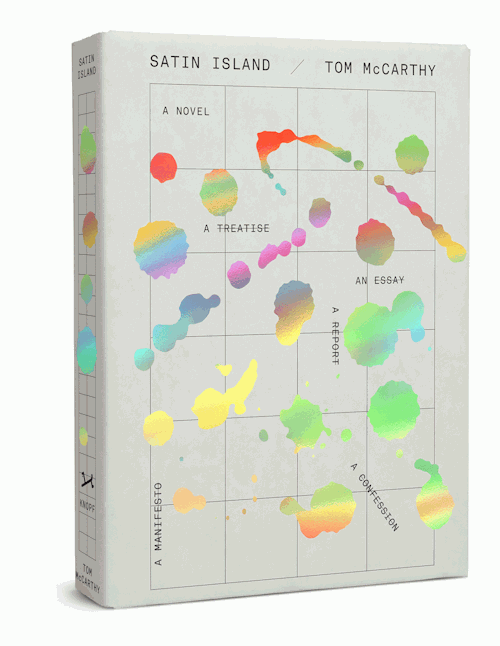
Satin Island
by Tom McCarthy
Knopf; 208 p.
In a 1996 interview with KCRW’s Michael Silverblatt, David Foster Wallace explained the dizzyingly broad sweet of his magnum opus, Infinite Jest, in terms of a culture-overload that was singularly specific to late capitalism:
‘it seems to me that so much of pre-millennial life in America consists of enormous amounts of what seem like discrete bits of information coming in and that the real kind of intellectual adventure is finding ways to relate them to each other and to find larger patterns and meanings…’
This was, for all intents and purposes, before the Internet. Two decades on, his observation resonates with even greater force, as a daily inundation of digital content further enervates our weary attention spans. Indeed the greater the cultural saturation, the more urgent the search for meaning becomes. The work of constructing narratives is integral to both consumer culture and governance; is too important to be left to amateurs. Just as the idealistic artists of the 1960s and 70s inevitably drifted into – dare I say defected to – the advertising business, so it falls to the humanities graduates of the 21st-century to populate the ranks of the public relations industry in its myriad guises: technicians, as it were, of the human soul.
U, the sparingly named protagonist of Tom McCarthy’s fourth novel, Satin Island, is one such foot-soldier. An anthropologist in the employ of a major corporate PR agency, he is under no illusions about the nature of his work, which he calls, with mordant candour, ‘paradigm advancement’. His mercurial boss has commissioned him to produce a Great Report: the brief is vague, but he is given to understand that it need only comprise the entire sprit of the age, condensed into a readable document. It is a dream gig.
But where to start? U’s training lets him down: Bronislaw Malinowski’s famous injunction to ‘Write Everything Down’ – a guiding precept of anthropological practice since the 1920s – could only have been conceived in a pre-digital world. To apply, in a modern metropolis, techniques honed on remote Vanuatan tribes is to ask for psychic trouble: U is plunged into a vortex of disparate narratives, merging procrastinatory online reading with esoteric fixations, anecdotal vignettes and Tao Lin-esque spirals of over-thinking:
I pictured a giant uber-server, housed somewhere in Finland or Nevada or Uzbekistan: stacks of memory banks, satellite dishes sprouting all around them, pumping out information non-stop, more of it than any single person would need in their lifetime, pumping it all the way in an endless, unconditional and grace-conferring act of generosity.
If U’s metier is a pointed commentary on the fate of the liberal arts in post-industrial society – as mercenary facilitators of high-end executive bullshit – Satin Island is, more broadly, a meditation on the nature of authorship. U’s anxieties over his Great Report play out like a novelist agonising over their work.
While my supposed business, my “official” function, was a corporate ethnographer, was to garner meaning from all types of situation – to extract it, like a physicist distilling some pure, unadulterated essence out of common-mongrel compounds, or a miner drawing gold ore from deep within the earth’s bowels – I sometimes allowed myself to think that, in fact, things were precisely the other way round: that my job was to put meaning in the world, not take it from it.
Satin Island bears a strong resemblance to another recent novel-about-nothing, Ben Lerner’s 10:04. Here, as in Lerner’s book, events at the periphery of the writing process somehow wind up becoming the story itself. That there is currently an appetite for this kind of fiction is a sign of our times: as digital social media have enabled all of us to conceive of our own lives as works of art, as malleable and marketable fictions, so the idea of authorship as curation – piecing together an impressionistic collage from a heterogeneous multiplicity that would otherwise resist teleological streamlining – resonates with the 21st-century reader, providing at least a partial answer to the question put by Eric Hobsbawm in a 2012 essay entitled ‘Heritage’:
‘How much of the great simultaneous circus show of sound, shape, image, colour, celebrity and spectacle that constitutes the contemporary cultural experience will even survive as a preservable heritage, as distinct from changing sets of generational memories occasionally revived as retro fashions? How much of it will be remembered at all?’
Perhaps, when cultural historians look back on this moment, they will identify its weightless absence of definition as its very hallmark: the remix, the metanarrative, the cut & paste. It is a discomforting thought for any author, raising as it does the spectre of redundancy. In one terrifying moment, it occurs to McCarthy’s U that the total digital transcript of contemporary human existence – the electronic paper-trail of correspondence, records, etc. – might actually comprise the fieldwork case study par excellence, the veritable Last Word:
[T]he truly terrifying thought wasn’t that the Great Report might be unwritable, but – quite the opposite – that it had already been written… And that we, far from being its authors … were no more than actions and commands within its key-chains.
And therein lies the not-inconsiderable challenge to the conceit of authorship today, to anyone seeking to impose a narrative on, or draw meaning from, our ‘great simultaneous circus show’: the world is a terribly, unfathomably complicated place; what can YOU bring to the party?
Houman Barekat is a London-based writer and founding editor of Review 31.
Follow Vol. 1 Brooklyn on Twitter, Facebook, Google +, our Tumblr, and sign up for our mailing list.
